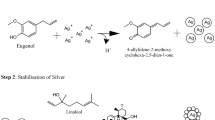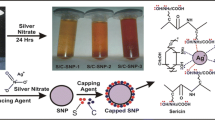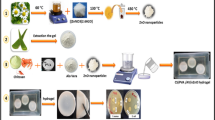Abstract
Grafting of quaternary nitrogen atoms into the backbone of polymer is an efficient way of developing new generation antimicrobial polymeric wound dressing. In this study, an elastic, non-adhesive and antimicrobial transparent hydrogel based dressing has been designed, which might be helpful for routine observation of wound area without removing the dressing material along with maintaining a sterile environment for a longer period of time. Green synthesized silver nanoparticles have been loaded into the quaternized PVA hydrogel matrix to improve its antimicrobial property. Silver nanoparticles loaded quaternized PVA hydrogel showed enhanced mechanical and swelling properties compared to native quaternized PVA hydrogel. Release kinetics evaluated by atomic absorption spectroscopy revealed that the release mechanism of silver nanoparticles from the hydrogel follows Fickian diffusion. Antimicrobial efficacy of the hydrogels was evaluated by disk diffusion test on Pseudomonas aeruginosa, Staphylococcus aureus and Escherichia coli. After 96 h of release in phosphate buffer, the growth inhibition zone created by silver nanoparticless loaded quaternized PVA hydrogel is comparable to that created by ampicillin. These observations assert that the silver nanoparticles loaded quaternized PVA hydrogel acts as a reservoir of silver nanoparticles, which helps in maintaining a sterile environment for longer time duration by releasing Ag nanocrystallite in sustained manner.
Graphical Abstract








Similar content being viewed by others

References
Sakai S, Tsumura M, Inoue M, Koga Y, Fukano K, Taya M. Polyvinyl alcohol-based hydrogel dressing gellable on-wound via a co-enzymatic reaction triggered by glucose in the wound exudate. J Mater Chem B. 2013;1(38):5067–75.
Gjødsbøl K, Christensen JJ, Karlsmark T, Jørgensen B, Klein BM, Krogfelt KA. Multiple bacterial species reside in chronic wounds: a longitudinal study. Int Wound J. 2006;3(3):225–31.
Fazli M, Bjarnsholt T, Kirketerp-Møller K, Jørgensen B, Andersen AS, Krogfelt KA, et al. Nonrandom distribution of Pseudomonas aeruginosa and Staphylococcus aureus in chronic wounds. J Clin Microbiol. 2009;47(12):4084–9.
Melaiye A, Youngs WJ. Silver and its application as an antimicrobial agent. Expert Opin Ther Pat. 2005;15(2):125–30.
Fong J, Wood F. Nanocrystalline silver dressings in wound management: a review. Int J Nanomedicine. 2006;1(4):441
Vlachou E, Chipp E, Shale E, Wilson YT, Papini R, Moiemen NS. The safety of nanocrystalline silver dressings on burns: a study of systemic silver absorption. Burns. 2007;33(8):979–85.
Poon VK, Burd A. In vitro cytotoxity of silver: implication for clinical wound care. Burns. 2004;30(2):140–7.
Cortese-Krott MM, Münchow M, Pirev E, Heβner F, Bozkurt A, Uciechowski P, et al. Silver ions induce oxidative stress and intracellular zinc release in human skin fibroblasts. Free Radic Biol Med. 2009;47(11):1570–7.
Kim JS, Kuk E, Yu KN, Kim J-H, Park SJ, Lee HJ, et al. Antimicrobial effects of silver nanoparticles. Nanomedicine Nanotechnol Biol Med. 2007;3(1):95–101.
Kim S-H, Lee H-S, Ryu D-S, Choi S-J, Lee D-S. Antibacterial activity of silver-nanoparticles against Staphylococcus aureus and Escherichia coli. Korean J Microbiol Biotechnol. 2011;39(1):77–85.
Kim TH, Kim M, Park HS, Shin US, Gong MS, Kim HW. Size‐dependent cellular toxicity of silver nanoparticles. J Biomed Mater Res A. 2012;100(4):1033–43.
Kora AJ, Beedu SR, Jayaraman A. Size-controlled green synthesis of silver nanoparticles mediated by gum ghatti (Anogeissus latifolia) and its biological activity. Organic Med Chem Lett. 2012;2(1):1–10.
Li W-R, Xie X-B, Shi Q-S, Zeng H-Y, You-Sheng O-Y, Chen Y-B. Antibacterial activity and mechanism of silver nanoparticles on Escherichia coli. Appl Microbiol Biotechnol. 2010;85(4):1115–22.
Maneewattanapinyo P, Banlunara W, Thammacharoen C, Ekgasit S, Kaewamatawong T. An evaluation of acute toxicity of colloidal silver nanoparticles. J Vet Med Sci. 2011;73(11):1417–23.
MacNeil S. Progress and opportunities for tissue-engineered skin. Nature. 2007;445(7130):874–80.
Bhowmick S, Koul V. Assessment of PVA/silver nanocomposite hydrogel patch as antimicrobial dressing scaffold: Synthesis, characterization and biological evaluation. Mater Sci Eng C. 2016;59:109–19.
Travan A, Pelillo C, Donati I, Marsich E, Benincasa M, Scarpa T, et al. Non-cytotoxic silver nanoparticle-polysaccharide nanocomposites with antimicrobial activity. Biomacromolecules. 2009;10(6):1429–35.
Jain J, Arora S, Rajwade JM, Omray P, Khandelwal S, Paknikar KM. Silver nanoparticles in therapeutics: development of an antimicrobial gel formulation for topical use. Mol Pharm. 2009;6(5):1388–401.
Widgerow AD. Nanocrystalline silver, gelatinases and the clinical implications. Burns. 2010;36(7):965–74.
Tocco I, Zavan B, Bassetto F, Vindigni V. Nanotechnology-based therapies for skin wound regeneration. J Nanomater. 2012;2012:4
Liu X, Py Lee, Ho CM, Lui VC, Chen Y, Che CM, et al. Silver nanoparticles mediate differential responses in keratinocytes and fibroblasts during skin wound healing. ChemMedChem. 2010;5(3):468–75.
Zhang Y, Jiang J, Chen Y. Synthesis and antimicrobial activity of polymeric guanidine and biguanidine salts. Polymer (Guildf). 1999;40(22):6189–98.
Feiertag P, Albert M, Ecker‐Eckhofen EM, Hayn G, Hönig H, Oberwalder HW, et al. Structural characterization of biocidal oligoguanidines. Macromol Rapid Commun. 2003;24(9):567–70.
Albert M, Feiertag P, Hayn G, Saf R, Hönig H. Structure–activity relationships of oligoguanidines influence of counterion, diamine, and average molecular weight on biocidal activities. Biomacromolecules. 2003;4(6):1811–7.
Tiller JC, Lee SB, Lewis K, Klibanov AM. Polymer surfaces derivatized with poly (vinyl‐N‐hexylpyridinium) kill airborne and waterborne bacteria. Biotechnol Bioeng. 2002;79(4):465–71.
Tiller JC, Liao C-J, Lewis K, Klibanov AM. Designing surfaces that kill bacteria on contact. Proc Natl Acad Sci. 2001;98(11):5981–5.
Park ES, Kim HS, Kim MN, San Yoon J. Antibacterial activities of polystyrene-block-poly (4-vinyl pyridine) and poly (styrene-random-4-vinyl pyridine). Eur Polym J. 2004;40(12):2819–22.
Li G, Shen J. A study of pyridinium‐type functional polymers. IV. Behavioral features of the antibacterial activity of insoluble pyridinium‐type polymers. J Appl Polym Sci. 2000;78(3):676–84.
Muñoz-Bonilla A, Fernández-García M. Polymeric materials with antimicrobial activity. Prog Polym Sci. 2012;37(2):281–339.
Muñoz-Bonilla A, Fernández-García M. The roadmap of antimicrobial polymeric materials in macromolecular nanotechnology. Eur Polym J. 2015;65:46–62.
Siedenbiedel F, Tiller JC. Antimicrobial polymers in solution and on surfaces: overview and functional principles. Polymers. 2012;4(1):46–71.
Gottenbos B, Grijpma DW, van der Mei HC, Feijen J, Busscher HJ. Antimicrobial effects of positively charged surfaces on adhering Gram-positive and Gram-negative bacteria. J Antimicrob Chemother. 2001;48(1):7–13.
Gottenbos B, van der Mei HC, Klatter F, Grijpma DW, Feijen J, Nieuwenhuis P, et al. Positively charged biomaterials exert antimicrobial effects on gram-negative bacilli in rats. Biomaterials. 2003;24(16):2707–10.
Sauvet G, Dupond S, Kazmierski K, Chojnowski J. Biocidal polymers active by contact. V. Synthesis of polysiloxanes with biocidal activity. J Appl Polym Sci. 2000;75(8):1005–12.
Mizerska U, Fortuniak W, Chojnowski J, Hałasa R, Konopacka A, Werel W. Polysiloxane cationic biocides with imidazolium salt (ImS) groups, synthesis and antibacterial properties. Eur Polym J. 2009;45(3):779–87.
Caillier L, de Givenchy ET, Levy R, Vandenberghe Y, Geribaldi S, Guittard F. Polymerizable semi-fluorinated gemini surfactants designed for antimicrobial materials. J Colloid Interface Sci. 2009;332(1):201–7.
Thebault P, de Givenchy ET, Géribaldi S, Levy R, Vandenberghe Y, Guittard F. Surface and antimicrobial properties of semi-fluorinated quaternary ammonium thiol surfactants potentially usable for self-assembled monolayers. J Fluor Chem. 2010;131(5):592–6.
Yang M, Santerre JP. Utilization of quinolone drugs as monomers: characterization of the synthesis reaction products for poly (norfloxacin diisocyanatododecane polycaprolactone). Biomacromolecules. 2001;2(1):134–41.
Halevy R, Rozek A, Kolusheva S, Hancock RE, Jelinek R. Membrane binding and permeation by indolicidin analogs studied by a biomimetic lipid/polydiacetylene vesicle assay. Peptides. 2003;24(11):1753–61.
Tamaki M, Kokuno M, Sasaki I, Suzuki Y, Iwama M, Saegusa K, et al. Syntheses of low-hemolytic antimicrobial gratisin peptides. Bioorg Med Chem Lett. 2009;19(10):2856–9.
Béven L, Castano S, Dufourcq J, Wieslander Å, Wróblewski H. The antibiotic activity of cationic linear amphipathic peptides: lessons from the action of leucine/lysine copolymers on bacteria of the class Mollicutes. Eur J Biochem. 2003;270(10):2207–17.
Jiang Q, Xu J, Li T, Qiao C, Li Y. Synthesis and antibacterial activities of quaternary ammonium salt of gelatin. J Macromol Sci Part B. 2014;53(1):133–41.
Zhao X, Li P, Guo B, Ma PX. Antibacterial and conductive injectable hydrogels based on quaternized chitosan-graft-polyaniline/oxidized dextran for tissue engineering. Acta Biomater. 2015;26:236–48.
Cydzik M, Rudowska M, Stefanowicz P, Szewczuk Z. Derivatization of peptides as quaternary ammonium salts for sensitive detection by ESI‐MS. J Pept Sci. 2011;17(6):445–53.
Zhu P, Sun G. Antimicrobial finishing of wool fabrics using quaternary ammonium salts. J Appl Polym Sci. 2004;93(3):1037–41.
Gupta S, Goswami S, Sinha A. A combined effect of freeze–thaw cycles and polymer concentration on the structure and mechanical properties of transparent PVA gels. Biomed Mater. 2012;7(1):015006.
Liu Y, Chan-Park MB. Hydrogel based on interpenetrating polymer networks of dextran and gelatin for vascular tissue engineering. Biomaterials. 2009;30(2):196–207.
Vrana NE, O’Grady A, Kay E, Cahill PA, McGuinness GB. Cell encapsulation within PVA-based hydrogels via freeze-thawing: a one-step scaffold formation and cell storage technique. J Tissue Eng Regen Med. 2009;3(7):567–72. doi: 10.1002/term.193
Peppas NA, Stauffer SR. Reinforced uncrosslinked poly (vinyl alcohol) gels produced by cyclic freezing-thawing processes: a short review. J Control Release. 1991;16(3):305–10.
Li JK, Wang N, Wu XS. Poly (vinyl alcohol) nanoparticles prepared by freezing–thawing process for protein/peptide drug delivery. J Control Release. 1998;56(1):117–26.
Bhowmick S, Das DK, Maiti AK, Chakraborty C. Structural and textural classification of erythrocytes in anaemic cases: a scanning electron microscopic study. Micron. 2013;44:384–94.
Bhowmick S, Das DK, Maiti AK, Chakraborty C. Computer-aided diagnosis of thalassemia using scanning electron microscopic images of peripheral blood: a morphological approach. J Med Imag Health Inform. 2012;2(3):215–21.
Bhowmick S, Scharnweber D, Koul V. Co-cultivation of keratinocyte-human mesenchymal stem cell (hMSC) on sericin loaded electrospun nanofibrous composite scaffold (cationic gelatin/hyaluronan/chondroitin sulfate) stimulates epithelial differentiation in hMSCs: in vitro study. Biomaterials. 2016;88:83–96. doi: 10.1016/j.biomaterials.2016.02.034
Koul V, Bhowmick S, Thanusha AV. Hydrogels for pharmaceutical applications. Handbook of polymers for pharmaceutical technologies. Wiley; Hoboken 2015. p. 125-44.
Ritger PL, Peppas NA. A simple equation for description of solute release II. Fickian and anomalous release from swellable devices. J Control Release. 1987;5(1):37–42.
Korsmeyer RW, Gurny R, Doelker E, Buri P, Peppas NA. Mechanisms of solute release from porous hydrophilic polymers. Int J Pharm. 1983;15(1):25–35.
Ye L, Zhai L, Fang J, Liu J, Li C, Guan R. Synthesis and characterization of novel cross-linked quaternized poly(vinyl alcohol) membranes based on morpholine for anion exchange membranes. Solid State Ionics. 2013;240:1–9. doi: 10.1016/j.ssi.2013.03.019
Jaiswal M, Dinda AK, Gupta A, Koul V. Polycaprolactone diacrylate crosslinked biodegradable semi-interpenetrating networks of polyacrylamide and gelatin for controlled drug delivery. Biomed Mater. 2010;5(6):065014
Boonkaew B, Kempf M, Kimble R, Supaphol P, Cuttle L. Antimicrobial efficacy of a novel silver hydrogel dressing compared to two common silver burn wound dressings: Acticoat™ and PolyMem Silver®. Burns. 2014;40(1):89–96.
Parsons D, Bowler P, Myles V, Jones S. Silver antimicrobial dressings in wound management: a comparison of antibacterial, physical, and chemical characteristics. Wounds Compend Clin Res Prac. 2005;17(8):222–32.
Dunn K, Edwards-Jones V. The role of Acticoat™ with nanocrystalline silver in the management of burns. Burns. 2004;30:S1–S9.
Deitch EA, Marino AA, Malakanok V, Albright JA. Silver nylon cloth: in vitro and in vivo evaluation of antimicrobial activity. J Trauma. 1987;27(3):301–4.
Xiong Y, Fang J, Zeng QH, Liu QL. Preparation and characterization of cross-linked quaternized poly (vinyl alcohol) membranes for anion exchange membrane fuel cells. J Membr Sci. 2008;311(1):319–25.
Schmedlen RH, Masters KS, West JL. Photocrosslinkable polyvinyl alcohol hydrogels that can be modified with cell adhesion peptides for use in tissue engineering. Biomaterials. 2002;23(22):4325–32.
Wan W, Campbell G, Zhang Z, Hui A, Boughner D. Optimizing the tensile properties of polyvinyl alcohol hydrogel for the construction of a bioprosthetic heart valve stent. J Biomed Mater Res. 2002;63(6):854–61.
Nagura M, Hamano T, Ishikawa H. Structure of poly (vinyl alcohol) hydrogel prepared by repeated freezing and melting. Polymer (Guildf). 1989;30(4):762–5.
Mbhele Z, Salemane M, Van Sittert C, Nedeljkovic J, Djokovic V, Luyt A. Fabrication and characterization of silver-polyvinyl alcohol nanocomposites. Chem Mater. 2003;15(26):5019–24.
Gupta S, Pramanik AK, Kailath A, Mishra T, Guha A, Nayar S, et al. Composition dependent structural modulations in transparent poly (vinyl alcohol) hydrogels. Colloids Surf B. 2009;74(1):186–90.
Gupta S, Webster TJ, Sinha A. Evolution of PVA gels prepared without crosslinking agents as a cell adhesive surface. J Mater Sci Mater Med. 2011;22(7):1763–72.
Acknowledgments
The authors acknowledge IIT Delhi for the financial support
Author information
Authors and Affiliations
Corresponding author
Ethics declarations
Conflict of interest
The authors declare that they have no conflict of interests.
Rights and permissions
About this article
Cite this article
Bhowmick, S., Mohanty, S. & Koul, V. Fabrication of transparent quaternized PVA/silver nanocomposite hydrogel and its evaluation as an antimicrobial patch for wound care systems. J Mater Sci: Mater Med 27, 160 (2016). https://doi.org/10.1007/s10856-016-5772-8
Received:
Accepted:
Published:
DOI: https://doi.org/10.1007/s10856-016-5772-8



